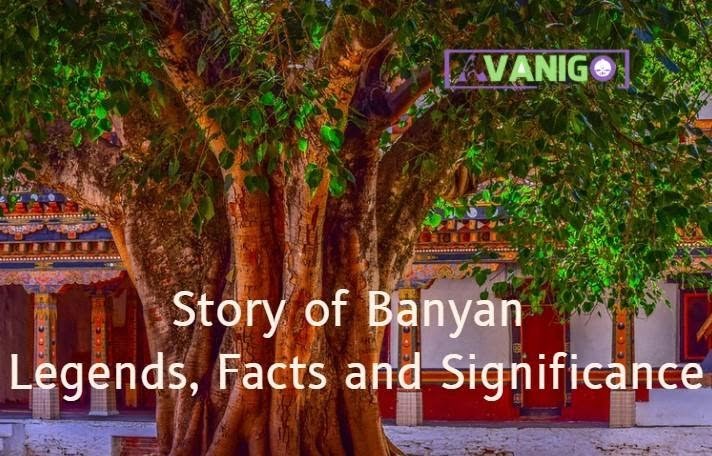The Indian national tree Banyan is more popular with the name Kalpavriksha in India. Banyan Indian tree is believed to be a wish-fulfilling and an immortal one. On the other hand, there is also a belief that devils and negative energies roam around this tree. Thus, there are many contradicting statements related to the Banyan tree. But once we discuss them in-depth, it becomes clear why Banyan is the national tree of India.
Why was Banyan made the Indian National tree?
According to the rules for national symbols, the chosen symbol should be:
- A native icon of India
- Easily identifiable by common man of India
- Should have cultural and mythological significance
Banyan – the national tree India satisfies these criteria with ease.
The banyan tree is a native of India. The scientific name of the Banyan tree is Ficus benghalensis. The name Banyan was coined by European traders who were marveled at the sight of Indian merchants (called Banias in Sanskrit) sitting under the cool shade of this gigantic tree. Banyan also holds much religious and cultural significance to Indians.
Banyan tree is also called Vata Vriksha (which means one that grows gigantically, without any death). Another name for the Banyan tree is Kalpavriksha, meaning the fulfiller of wishes.

Significance of Banyan tree in Hinduism
Banyan is associated with Lord Shiva, Vishnu, Yama and also considered as the symbol of knowledge in Hinduism.
The symbolism of Trimurti: Hindus consider Banyan as the symbolic representation of Trimurti – Brahma (The Creator), Vishnu (The Protector), and Shiva (The Destroyer). As per Hindu scriptures, the Trimurti resides in various parts of a Banyan. Lord Brahma in the roots, Lord Vishnu in the bark, and Lord Shiva in the aerial roots.
Home for Lord Shiva: This Vata vriksha is the home for Lord Shiva. A banyan is known to be free from change and considered immortal. Similarly, Lord Shiva who is always present in the form of his Linga loves to reside under the Banyan tree all the time. According to another belief, the countless branches a banyan tree gives are symbolic of Lord Shiva’s Divine Hair (Jhuta Jhuta).
Abode of Dakshinamurthi: In his other form as Dakshinamurthi, Lord Shiva is seen sitting South Facing. South is considered as the direction of Yama, the Lord of Death. Thus, Dakshinamurthi who sits facing the South is considered to be unafraid of death and change.
Association with Lord Vishnu: Lord Vishnu loves to sleep on the Banyan leaf in his form Krishna. Banyan leaves are wide and soft. During the Maha Pralaya, the final dissolution of the Universe, Lord Krishna appears on the Banyan leaf in the form of a newborn sucking his toe. And Sage Markandeya witnesses this.
This is the reason why Lord Vishnu is also called Vata Patra Sai. Means one who sleeps on the Vata patra (Banyan-leaf) like a child. In Bhagavad Gita, Lord Krishna said – “Amongst all trees, I am the vata vriskha (banyan tree)!
India vs Bharat: The Significance of the Name Bharat
Symbol of Knowledge: Banyan – the national tree India is a symbol of knowledge as per Hinduism. There are two types of knowledge according to Hindu scriptures – temporary and permanent.
Temporary knowledge is related to the Grihastha (family man dharma) while Permanent knowledge is associated with Sanyasa (Hermit life). Banyan represents the hermit life.
One who seeks the shade of Banyan for enlightenment will be gifted with permanent knowledge related to Sanyasa. This becomes clear from the fact the Lord Buddha attained enlightenment after sitting under a Banyan tree for 7 days.
It is for the same reason, Lord Shiva who renounced worldly pleasures always loves to sit under the Banyan tree.

The science behind the banyan tree
Banyan – the Indian tree belongs to the fig family. It propagates when its seed falls on the crack of another tree. Thus, no other plant can sustain near the banyan tree. It uses all the nearby trees for its propagation and keeps growing limitlessly.
The seeds of the Banyan tree are spread by birds that feed on the tree’s fruits. When they disperse the seeds into other places, new banyan trees crop up.
The uniqueness of the Banyan tree lies in its aerial roots. These roots bend towards the ground, eventually gain a hold into the soil and offer strength to the tree. For onlookers, it appears as if one tree is the agglomerate of many trees. But in practice, the reverse is true. One tree gives rise to many roots, and over time the Mother root degrades and disappears. This is why this Indian national tree is also called Bahupada – the one with many legs.
Also Read: Why peacock is the national bird of India?
Cultural Significance of Indian National Tree Banyan
- The Indian tree Banyan is one of its kind. People grow them in villages as a bringer of luck and wealth. However, in most villages, they are found in the outskirts due to their association with negative energies.
- In villages, banyan trees are often the stage for gatherings and meetings during the daytime. The foliage of this Indian national tree is so woven and shady that even during the peak of the summers, one can find a cool breeze under the banyan tree. Also in Summer people love to eat Indian national fruit mango.
- The worship of the Banyan tree is not new to India. This Indian tree is worshipped for ages for many reasons. Women of North India perform a puja called Vata Savitri. Accordingly, they worship this tree on new moon day for the longevity of their husbands.
- Banyan also is associated with Lord Yama. It is for this reason; Banyan trees are mostly found near burial grounds and crematoriums. It is a popular belief that unsatisfied souls hang to the branches of a Banyan in the form of vetals, devils, and spirits.
- Though banyan is known for its shade, it is never a source of food for humans. It does not allow any other plant to grow in its shade. Thus, it is considered a prohibited plant for auspicious ceremonies like marriage and childbirth. The tree represents constancy – an entire opposite to change, which marriage and birth represent.
- This Indian tree is also significant as per astrology. Pandits specify many remedies related to this National tree to overcome astrological troubles. Also Read: Indian Moral Tales for your children

Use of Banyan as per Ayurveda
Ayurveda shows that Banyan is a cure for many ailments. The bark of this Indian tree is useful to control the bleeding of wounds. The sap is also useful in treating piles, rheumatism, pain, and lumbago. Read types of mangoes in India.
Interesting facts about Banyan Tree
- The banyan tree is the widest in the whole plant kingdom. For this specialty, it even entered the Guinness Book of World Records.
- Apart from the revered Great Banyan in Kolkata, other famous banyan trees in India are located in Anantapur (Andhra Pradesh), Ramohalli (Bangalore), and on the campus of Theosophical Society (Chennai).
- A single banyan tree can be called a micro-forest because it is a shelter for a variety of species including birds, wasps, and bats.
- The Great Banyan at the Acharya Jagadish Chandra Bose Botanical Garden near Kolkata in India is the world’s largest Banyan tree.
- Banyan trees are significant outside India too. They are worshipped, revered, and grown in Indonesia, Vanuatu (an island in the Pacific), the Philippines, and Vietnam.
- The mention of Banyan is found in The Paradise Lost of the great English writer John Milton. In his book, he mentions that it is with the banyan leaves that Adam and Eve covered their nudity after eating the forbidden apple.
- It is said that during the British era, British rulers used to hang Indian freedom fighters who resisted British rule to the banyan trees .
- Banyans are mostly disappearing in cities due to the space they occupy. However, tree lovers in cities can grow its Bonsai version at home easily.
All in all, Banyan symbolizes immortality, constancy, knowledge, longevity, growth, and prosperity. Hence, the banyan tree is made the national tree of India.
Also Read: Why hockey is the national game of India?

